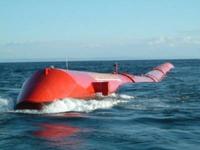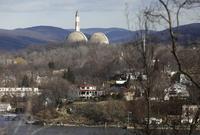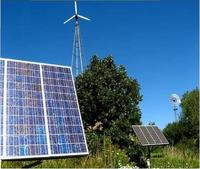-
Microbial power storage can do the job
Oil and gas can be converted into electricity in line with demand, but wind, water, and sun cannot be adapted as readily to fluctuations in power consumption. Efficient power storage solutions must satisfy two essential criteria: Their own consumption of resources must be as low as possible, and surplus power must be stored within seconds. The results of a pilot study have now demonstrated that a microorganism-based process developed by is unequalled in the way it satisfies both of these criteria.
-
-
Today’s worst watershed stresses in U.S. may become tomorrow’s new normal
Nearly one in ten U.S. watersheds is “stressed,” with demand for water exceeding natural supply, according to a new analysis of surface water in the United States. What is more, the lowest water flow seasons of recent years — times of great stress on rivers, streams, and sectors that use their waters — are likely to become typical as climates continue to warm.
-
-
Extracting maximum energy from currents

In the long sprint to find new sources of clean, low-cost power, slow and steady may win the race — the slow-moving water of currents and tides, that is. Just as wind turbines tap into the energy of flowing air to generate electricity, hydrokinetic devices produce power from moving masses of water.
-
-
World's first grid-scale isothermal compressed air energy storage system
A New Hampshire company has completed construction and begun startup of the world’s first megawatt-scale isothermal compressed air energy storage (ICAES) system. The system stores and returns megawatts of electricity to provide long-term grid stability and support integration of renewable energy sources like wind and solar. Unlike chemical battery systems, ICAES performance does not degrade over its lifetime or need frequent replacement. No hazardous materials are used.
-
-
U.S. makes progress toward a National Water Census
Growing populations, increased energy development, and the uncertain effects of a changing climate magnify the need for an improved understanding of water use and water availability. No comprehensive and current national assessment of water resources exists, however. A USGS report released in April, Progress Toward Establishing a National Assessment of Water Availability and Use, fulfilled a requirement under the 2009 SECURE Water Act for the Secretary of the Interior to report to Congress on progress made in implementing the national water availability and use assessment program, also referred to as a National Water Census.
-
-
October is National Cybersecurity Awareness Month
This October marks the tenth National Cyber Security Awareness Month (NCSAM), an effort to educate millions of people each year about the importance of online safety and security. During the month, leaders from the public and private sectors will come together to advance its universal theme that protecting the Internet is “Our Shared Responsibility.”
-
-
Children living close to nuclear power plants do not have higher risk of developing leukemia

Young children who live near nuclear power plants do not have a greater risk of developing childhood leukemia or non-Hodgkin Lymphoma according to new research. Researchers conducted a study of almost 10,000 children under five years of age who were diagnosed with leukemia or similar cancers in Britain between 1962 and 2007. The scientists measured the distance from the nearest nuclear power plant both at birth and when diagnosed with childhood leukemia or non-Hodgkin lymphoma, and found that there was no apparent extra risk living near a nuclear power plant.
-
-
Sewage treatment removes widely used home and garden insecticides from wastewater
Even though sewage treatment plants are not designed to remove tiny amounts of pesticides, they do an excellent job of dealing with the most widely used family of home and garden insecticides, scientists reported. The use of pyrethrins, derived from chrysanthemum flowers, and the related synthetic pyrethroids, has been on the increase during the last decade. Researchers found that advanced sewage treatment reduced the levels of pyrethroids by more than 97 percent.
-
-
Calculating the cost of a ton of mountaintop removal coal
To meet current U.S. coal demand through surface mining, an area of the Central Appalachians the size of Washington, D.C., would need to be mined every eighty-one days. This is about sixty-eight square miles — or roughly an area equal to ten city blocks mined every hour. A 1-year supply of coal would require converting about 310 square miles of the region’s mountains into surface mines.
-
-
Canada addresses environmental concerns over Keystone XL
Canadian prime minister Stephen Harper sent a letter to President Barack Obama last month offering to participate in joint efforts to reduce greenhouse-gas emissions in order to win approval of the Keystone XL Pipeline. Harper’s offer may allow Obama to approve the project without having to confront environmental groups.
-
-
Cyberweapons likely to be an integral part of any U.S.-Syria clash
A U.S.-led military attack on Syria may have been averted, at least for a while, by the Russian proposal to negotiate the transfer of Syria’s chemical weapons stocks to international control, but had the United States gone ahead with a strike, there is little doubt that cyberattacks would have been used by both sides. If the United States decides to attack Syria in the future, we should expect cyberweapons to be used.
-
-
Cold-formed steel rebuilds earthquake-resistant architecture
When engineers attempt to make a building earthquake-resistant, they use specific structural components, appropriately called details, to absorb earthquake forces and help direct some of those forces back to the ground. That works, but when an earthquake hits, the entire building reacts, not just the sections containing details. Even though academic research has led to improvements to the original building codes over the decades, there is much to be learned about the entire system of a cold-formed steel building as it responds to an earthquake.
-
-
Calculating the energy required to store wind and solar power on the grid

Renewable energy holds the promise of reducing carbon dioxide emissions. There are times, however, when solar and wind farms generate more electricity than is needed by consumers. Storing that surplus energy in batteries for later use seems like an obvious solution, but a new study from Stanford University suggests that might not always be the case.
-
-
New technique developed to assess the cost of major flood damage
A new approach to calculating the cost of damage caused by flooding was presented at the International Conference of Flood Resilience: Experiences in Asia and Europe which was held last week. The methodology combines information on land use with data on the vulnerability of the area to calculate the cost of both past and future flooding events.
-
-
“Climate Change, Water Conflicts, and Human Security” report released
Increasingly, climate change and the associated increase in the frequency of extreme weather events such as floods, droughts, and rising sea level, are acknowledged as not only having humanitarian impacts, but also creating national and regional political and security risks. While people and governments can adapt to these impacts, their capacity to do so varies.
-
More headlines
The long view
Water Wars: A Historic Agreement Between Mexico and US Is Ramping Up Border Tension
As climate change drives rising temperatures and changes in rainfall, Mexico and the US are in the middle of a conflict over water, putting an additional strain on their relationship. Partly due to constant droughts, Mexico has struggled to maintain its water deliveries for much of the last 25 years, deliveries to which it is obligated by a 1944 water-sharing agreement between the two countries.
Trump Is Fast-Tracking New Coal Mines — Even When They Don’t Make Economic Sense
In Appalachian Tennessee, mines shut down and couldn’t pay their debts. Now a new one is opening under the guise of an “energy emergency.”
Smaller Nuclear Reactors Spark Renewed Interest in a Once-Shunned Energy Source
In the past two years, half the states have taken action to promote nuclear power, from creating nuclear task forces to integrating nuclear into long-term energy plans.
Keeping the Lights on with Nuclear Waste: Radiochemistry Transforms Nuclear Waste into Strategic Materials
How UNLV radiochemistry is pioneering the future of energy in the Southwest by salvaging strategic materials from nuclear dumps –and making it safe.
Model Predicts Long-Term Effects of Nuclear Waste on Underground Disposal Systems
The simulations matched results from an underground lab experiment in Switzerland, suggesting modeling could be used to validate the safety of nuclear disposal sites.
